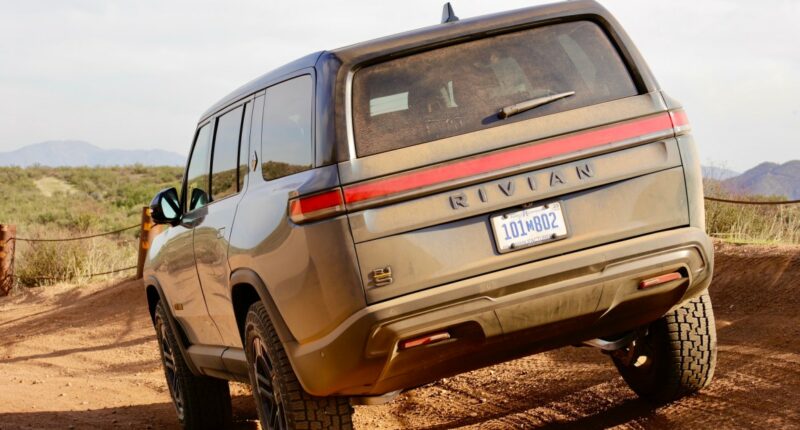Share this @internewscast.com
Just four years after Rivian started selling its R1T truck, 2025 ushers in the second generation of the R1T and R1S models. While their exteriors remain largely unchanged, the evolution beneath the surface is significant, featuring a completely new electric framework, revamped motor setup, enhanced suspension, and more. Beginning at $107,700, these updates establish the 2025 Rivian R1S Premium Tri-Motor as a leading contender in the contemporary EV market.
The tri-motor configuration sits between the entry-level dual-motor and the flagship quad-motor options and powered my review vehicle for an entire week. It generates a total output of 805 horsepower and 1,105 pound-feet of torque, propelling the vehicle from 0 to 60 mph in just 2.9 seconds. The only battery option available is Rivian’s Max spec with a capacity of 141.5 kWh, featuring a charging rate of 220 kW and offering a range between 371 and 405 miles depending on power settings and driving habits. Throughout my time with the vehicle, I achieved 340 miles in a balanced mix of highway, off-road, and urban driving.
But this isn’t the only significant update to the R1S’ EV architecture.
“We redesigned all the electronics and harnesses in the vehicle from scratch, strategically placing controllers to minimize the number of wires,” explained Kyle Lobo, Director of Electrical Architecture at Rivian, in a recent interview. Lobo and his team organized them in east, west, and south orientations, positioning them near the components they manage and then networking them together. By reducing the number of ECUs from 17 to just seven, the overall system weight was trimmed by 44 pounds and eliminated more than 1.6 miles of wiring. This enhancement also streamlines manufacturability; fewer components and wires mean quicker assembly. Moreover, all ECUs are now produced in-house, further accelerating production and enhancing independence from external suppliers.
Another big change is software-resettable e-fuses which monitor current and voltage on every line. When something goes wrong, Rivian relays this information to its service team and the owner. This further bolsters overall simplicity, and lays the groundwork for the company’s future R2 and R3 models.
When it comes to a screen-heavy user interface, I’m usually a bit of a Luddite; the more physical buttons the better. However, Rivian’s infotainment system was quite refreshing and easy-to-use, with no lag moving between screens and settings and great response. Its 15.6-inch screen’s resolution followed suit, and while I thought I’d miss the familiarity of Apple CarPlay, the brand’s in-house software was an excellent substitute. Besides some lag while scrolling through a particularly large Spotify playlist, it was all quite intuitive. Going one further, this was my first time utilizing an app-based digital key to start and stop the vehicle, and Rivian’s software made it a seamless and trouble-free transition.
Additionally, automatic emergency braking, lane departure warning, and adaptive cruise control are standard, and just as seamless and smooth in their operation as getting up to speed with the rest of the R1S’ tech. Automatic emergency braking came in clutch on one occasion, in the rain and in response to a clueless Los Angeles driver—it hauled all 7000+ lbs down to a stop in an assured manner.
Overall, the 2025 Rivian R1S possessed an everyday SUV-like driving experience. It didn’t feel like a forward-thinking, futuristic concept of mobility, but rather drove as if it were part of GMC or Lincoln’s traditional ICE lineups. Though, with one caveat: Its standard, re-tuned-for-2025 air suspension had an excellent overall ride quality, and even felt agile in its more performance-oriented setting.
Then, of all the EVs I’ve driven over the years with one-pedal driving, the R1S was the easiest to master. Some systems require a bit more brain-to-throttle calibration than usual, but I enjoyed my tester’s three levels of intensity, and altered them frequently depending on the mood or amount of regeneration I was aiming for.
Besides being marketed as a spacious, three-row full-size EV truck, the R1S is also designed for off-the-pavement work, which I got the chance to try out up north of Los Angeles in a series of mountainside trails. With a 35.8-degree approach, 29.6-degree breakover, and 34.4-degree departure angle, plus an impressive 15 inches of ground clearance, it shrugged off some tricky sections where pitch and roll became rather excessive. One-pedal driving made the experience all-the-more enjoyable, too, as it allowed for incredibly precise throttle control.
Sporting Rivian’s All-Terrain package, my tester’s 20-inch Pirelli tires never lost their footing while ascending some properly brutal ascents. I was glad to have such trail-ready treads as added insurance against any potential sidewall cuts over particularly rocky bits. Finally, there weren’t any downsides in terms of road noise when I returned to paved tarmac, though Rivian says this package will reduce range by 10-15 percent.
Besides an ever-so-slight software glitch using Spotify, I had a hard time finding anything annoying or lacking in the 2025 Rivian R1S. I never drove any previous iteration of the R1, but it’s cool to see that, in just a few short years, this smaller—yet increasingly larger—name in EVs has made something this good, and makes me all-the-more excited to see how the R2 and R3 shake out when they arrive.
Photography by Peter Nelson / The Verge








